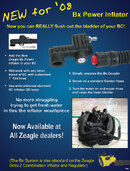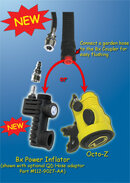I have a co-worker who is of the opinion that dunking a BC with the integrated Octo/Inflator disconnected "floods" the regulator. I have seen the small caps for the low-pressure connector (on both standard and integrated inflators I thought) but never thought they were for keeping water out of the reg; even if water gets in, the first use of the reg pushes the water out, just like a traditional 2nd stage, right? We are still training PADI divers to disconnect this fitting as remedy for constant BC inflation, right?
You are using an out of date browser. It may not display this or other websites correctly.
You should upgrade or use an alternative browser.
You should upgrade or use an alternative browser.
Q's about cleaning Alternate/Inflator BC's
- Thread starter MauiScubaSteve
- Start date
Please register or login
Welcome to ScubaBoard, the world's largest scuba diving community. Registration is not required to read the forums, but we encourage you to join. Joining has its benefits and enables you to participate in the discussions.
Benefits of registering include
- Ability to post and comment on topics and discussions.
- A Free photo gallery to share your dive photos with the world.
- You can make this box go away
I have a co-worker who is of the opinion that dunking a BC with the integrated Octo/Inflator disconnected "floods" the regulator. I have seen the small caps for the low-pressure connector (on both standard and integrated inflators I thought) but never thought they were for keeping water out of the reg; even if water gets in, the first use of the reg pushes the water out, just like a traditional 2nd stage, right? We are still training PADI divers to disconnect this fitting as remedy for constant BC inflation, right?
halemano,
Water would usually enter only to the second stage seat which is closed. Don't purge. If capped at the inflator inlet probably no water would get in.
Zeagle has a better way to rinse an BC... just unscrew the AIR and leave it hooked up to the reg.
Chad
Attachments
....snip... even if water gets in, the first use of the reg pushes the water out, just like a traditional 2nd stage, right? quote]
Right....generally speaking, scuba gear should not be harmed by water.
I like the Zeagle idea that Chad posted, the fitting might make a good accessory to add to all inflator/second stage bc hoses.
c
R
redacted
Guest
Dunking, or better yet soaking, and octo/inflator will not harm it. You just want to make sure you shake or purge the water out of the inlet and dry it, along with the rest of your gear before you store it. And don't do anything that will let water back into the first stage. That is where corrosion and deposit problems can occur as it is difficult to clean and dry any water, and whatever travels with it, that gets into a 1st stage and dynamic seating surfaces are subject to damage.
beanojones
Contributor
- Messages
- 3,204
- Reaction score
- 350
As someone who did lots and lots of pseudo overhauls on Leaky Air2's, I would say that not capping the LP connector port makes them corrode and thus leak. Flooding any second stage, especially a balanced one (which Air2's are not), is not good for it. And in the case of Air2's, it seems to be bad for it. But there is really know way of knowing if the corrosion is from rinsing, or from drip drip drip of salt water getting into the inlet before rinsing the gear
Seaquest has even taken to the step of hard connecting the alternate inflator reg with a regular LP hose. In that case you have to separate the corrugated BC hose to disconnect from the BC.
Yes PADI 'still' teaches LP inflator hose disconnection. But note, they only recently started teaching it, relatively speaking.
Seaquest has even taken to the step of hard connecting the alternate inflator reg with a regular LP hose. In that case you have to separate the corrugated BC hose to disconnect from the BC.
Yes PADI 'still' teaches LP inflator hose disconnection. But note, they only recently started teaching it, relatively speaking.
R
redacted
Guest
As someone who did lots and lots of pseudo overhauls on Leaky Air2's, I would say that not capping the LP connector port makes them corrode and thus leak. Flooding any second stage, especially a balanced one (which Air2's are not), is not good for it. And in the case of Air2's, it seems to be bad for it. But there is really know way of knowing if the corrosion is from rinsing, or from drip drip drip of salt water getting into the inlet before rinsing the gear
Seaquest has even taken to the step of hard connecting the alternate inflator reg with a regular LP hose. In that case you have to separate the corrugated BC hose to disconnect from the BC.
Yes PADI 'still' teaches LP inflator hose disconnection. But note, they only recently started teaching it, relatively speaking.
Lets look at this from the standpoint of what exactly is being damaged by soaking (or damaged by not soaking). The parts we are talking about are the inside of inlet tube, the inside of the orifice, and the the area of the LP seat that is inside the knife edge of the orifice. The rest of the octo/inflator is exposed to water normally during the dive.
The inlet tube is chrome plated brass and is not going to be harmed by exposure to water as long as it is cleaned and dried before storage. The orifice is brass. the outside of the orifice, including the threaded surface that engages the metal housing, is exposed to water normally. That threaded surface can be a problem if not adequately cleaned and dried. But the smooth inner surface which normally does not see water in use is not very susceptible to corrosion as long as it is dried after soaking before storage. The LP seat is not effected by water. The most vulnerable surface of the orifice is the knife edge of the orifice, the outside of which is normally exposed to water and the inside which is not. As long as the orifice is cleaned and dried adequately, water on the inside of the knife edge is not more damaging than water on the outside of it. So what is being damaged by soaking these surfaces as long as they are dired prior to storage.
I used to use an Air2 and my wife still does. It is my opinion that installing the cap on the coupling immediately after use may actually cause corrosion problems. I say this because I have observed water drops from wet gear and divers enter the inlet tube as the QD is disconnected. Capping that coupling right after the QD is disconnected can trap water inside the inlet tube or, most problematically, at the knife edge of the orifice. With the cap in place, that would result in deposits and/or corrosion forming on the inside of the knife edge which will cause leaks as the seating is compromised.
The cap is required to protect the surface of the inlet tube from damage (nicks and dings) which might prevent the QD from seating correctly. Using it to keep clean FW out while soaking may actually cause more harm than it prevents.
halocline
Contributor
Flooding any second stage, especially a balanced one (which Air2's are not), is not good for it.
Well, then I guess we better stop taking our second stages on dives, because what do you imagine happens to any second stage while underwater? Unless you're breathing off of it, it becomes filled with water, ergo, flooded. And what is about balanced regs that makes flooding especially bad for them?
I don't know if you're trying to say something very different than what your post indicates, but if you really mean to say that getting water inside 2nd stages is bad for them, you must have some unusual 2nd stages.
Diver Kat
Contributor
Zeagle has a better way to rinse an BC... just unscrew the AIR and leave it hooked up to the reg.
Chad
I like the Zeagle idea that Chad posted, the fitting might make a good accessory to add to all inflator/second stage bc hoses.
Recently upgraded from the Zeagle Octo+ to the Zeagle Octo-Z and it's great! Not only does my octo now stay connected to my reg, but the inflator hose on the BC hooks up to any standard garden hose to rinse out the BC with fresh water! It's now so much easier to give the inside of the BCD a real good cleaning after a trip.
beanojones
Contributor
- Messages
- 3,204
- Reaction score
- 350
Lets look at this from the standpoint of what exactly is being damaged by soaking (or damaged by not soaking). The parts we are talking about are the inside of inlet tube, the inside of the orifice, and the the area of the LP seat that is inside the knife edge of the orifice. The rest of the octo/inflator is exposed to water normally during the dive.
Here's the deal: What your particular gear does is indicative of what your gear does, not what gear in general does.
What should be true in theory is one thing. What is true in fact is another. And the fact is that Air2's that are uncapped crap out far more often than those that are not capped. Inflators that use O- rings instead of Tire valves will (and do) suffer the same fate. I dove with thousands and thousands of different divers, and fixed hundreds of leaky Air2's (and S/P balanced inflators.) They all crap out at the O-rings on the orifice, and on the supply button. Two areas which are supposed to be dry in operation.
The best bet is to leave it all hooked up. But most people do things the way they were taught, and they were taught to disassemble. If you are going to disassemble capping (with a dry unsalty cap) is better than nothing. But it is not as good as not taking it apart in the first place.
...snip...Here's the deal: What your particular gear does is indicative of what your gear does, not what gear in general does.....
I'm not clear what our friend means to say here, but
let's get back to the crux of the OP's question.
Will dunking a combo inflator/second stage flood it?
Yes....but as Awap and others have pointed out, soaking it in fresh water after a dive trip in the same manner will prevent salt from crystallizing in it.
After a good soak, blow air through the regulator and inflator and thoroughly dry it prior to storage. Failing to do so and you will have Beano and company fixing it for you.
Again, diving gear is designed to tolerate water.
couv
Last edited:
Similar threads
- Replies
- 1
- Views
- 1,072
- Replies
- 8
- Views
- 2,077
- Replies
- 0
- Views
- 982
- Replies
- 0
- Views
- 796





